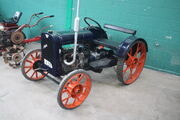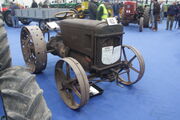
A restored Austin 20 hp tractor at Bath and Southwest Tractor show 2009

A restored Austin 20hp tractor showing the rhs of the engine
The Austin Motor Company was a British manufacturer of automobiles that rose to be a major brand, which made tractors for the period between the wars 1919-1939, both in England and in France. The also built Light and medium trucks for the Military in the war years.
They are best known for their Car production, as the dominant partner after merger with Morris in 1952 and later after being absorbed into British Leyland Motor Corporation became one of many brands. The Austin brand was best know for the Austin Metro in the later years.
History
1905 - 1918: Formation and development
Herbert Austin (1866–1941), later Sir Herbert, the former manager of the Wolseley Tool and Motor Car Company founded The Austin Motor Company in 1905, at Longbridge, which was then in Worcestershire (Longbridge was a village next to Northfield became part of Birmingham in 1911 when its boundaries were expanded). The first car was a conventional 5 litre four cylinder model with chain drive with about 200 being made in the first five years. In World War I Austin grew enormously with government contracts for everything from artillery to aircraft and the workforce expanded from around 2,500 to 22,000.
1919 - 1939: Interwar success
After the First world war Herbert Austin decided on a one model policy based around the 3620 cc 20 hp engine and versions included cars, commercials vehicles and even a tractor but sales volumes were never enough to fill the vast factory built during war time and the company went into receivership in 1921 but rose again after financial restructuring.
The Austin tractor was well received in France but as there was tariffs protection in place, it was too costly so to get round the problem Austin bought a farm and a factory in France, he then imported them back in to Britain instead. Production continued in the UK till 1927 on a small scale.
Critical to the recovery was the appointment in 1922 of a new finance director, Ernest Payton with the backing of the Midland Bank, and a new works director in charge of car production, Carl Engelbach, at the insistence of the creditors' committee. This triumvirate of Austin, Payton and Engelbach steered the company's fortunes through the inter-war years.
To expand the market share smaller car models were introduced with the 1661 cc Twelve in 1922 and later the same year the Austin 7, an inexpensive, small and simple car and one of the earliest to be directed at a mass market. At one point it was built under licence by the fledgling BMW of Germany (as the Dixi); Japanese Datsun; as Bantam in the United States; and as the Rosengart in France.
A largely independent U.S. subsidiary operated under the name American Austin Car Company from 1929 to 1934; it was revived under the name "American Bantam" from 1937 to 1941.
At the 1933 Paris show Austin displayed a new range of large Kerosene tractors of up to 55hp. A 45/55 hp diesel model was also produced in France.
Austin's French tractor production ended with WWII as the German company Krupp took over the factory during the war.
With the help of the Seven, Austin weathered the worst of the depression and remained profitable through the 1930s producing a wider range of cars which were steadily updated with the introduction of all-steel bodies, Girling brakes, and synchromesh gearboxes but all the engines remained as side valve units. Deputy chairman Ernest Payton became chairman in 1941 on the death of Herbert (now Lord) Austin. In 1938 Leonard Lord joined the company board and became chairman in 1946 on the death of Ernest Payton.
1939 - 1958: The war years and afterwards
During the Second World War Austin continued building cars but also made trucks and aircraft, including the construction of the Lancaster bombers of 617 squadron, better known as the Dambusters. The post war car range was announced in 1944 and production of it started in 1945.
The immediate post war range was mainly similar to that of the late 1930s but did include the 16 hp significant for having the companies first overhead valve engine.
In 1952 Austin merged with the Nuffield Organisation (parent company of Morris) to form the British Motor Corporation with Leonard Lord in charge. Austin was the dominant partner and its engines were adopted for most of the cars; various models amongst the marques would soon be badge-engineered versions of each other.
Also in 1952, Austin did a deal with Donald Healey, the renowned automotive engineer. It led to a new marque, Austin Healey, and a range of sports cars.
Commercial vehicles

An Austin K2 reg BUJ 774 fitted with a dropside body
Austin also made commercial vehicles;
Austin K2
The Austin K2 was built from the pre war period through the 2nd World war and supplied to the forces and to allies like Russia. A lot were used in the North African campaign.
Austin K5
The Austin K5 was a truck built in the war for military use.
Austin FG
The FG was previously the Morris FG and was called (by some) the workhorse that kept Britain running in the 1960s. These Austin FGs and later the Leyland FGs all had petrol or diesel long-stroke engines, producing good torque, but very little in the way of speed (40 mph was a good speed out of these vehicles). Leyland were to take over the FG, but before they did, in 1964, the BBC (British Broadcasting Corporation) commissioned six rolling chassis FGs to be coach built by a Middlesex company, Palmer Coach-builders. These six vehicles, registration 660 GYE to 666 GYE, were outdoor broadcast scenery vehicles.
Four-wheel drives
- Main article: Austin Gipsy
Austin built a Four-wheel drive Jeep/Landrover type vehicle for a period post war based on wartime models. This was called the Austin Gipsy, but sales were not as successful as the Land Rover and production ended after the merger with Leyland.
Austin factories
- Main article: Wikipedia:Longbridge
Austin's original plant was in Rotherham, however Herbert Austin relocated to an abandoned paint works at Longbridge, Birmingham. Due to its strategic advantages over Morris' Cowley plant, Longbridge became British Leyland's main factory. Following the Austin marque been dropped in 1989, Rover and MG continued to use the plant. The collapse of MG Rover meant it was not used from 2005 until MG production restarted in 2008, on a limited scale. Large areas of the site have been cleared in 2008 for redevelopment proposals.
Models
- See also: List of Austin motor cars
Ambulances
- LD3
- WWII Austin K2 - variant
Cars
For Cars see Austin Motor Company article
Commercial Vehicles
Including both Lorries and vans models
- Austin 702 7 ton
- Austin Series III
- Austin K2 'Katy' Ambulance (star of film Ice-Cold in Alex)
- Austin K4
- Austin K5
- Austin K6
- Austin K8 1947-1954
- Austin K9
- Austin 6cwt (re-badged Morris Minor) 1953-1971
- Austin A30 van 1954-1956
- Austin A35 van 1956-1968
- Austin 101 1957-1961 "badge engineered" version of Morris JB
- Austin A55 and A60 van 1958-1972
- Austin A40 van and pick-up
- Austin Mini van 1960-1982 and pick-up 1961-1982
- Austin 1800 pick-up (Australia only) 1968-1971
- Austin Metro van 1982-1990
- Austin Maestro van 1985-1994
Military vehicles
- WWI Austin Armoured Car
- WWII Austin Ten Utility Truck
- WWII Austin K2
- Austin Champ, 1947-56
- 1958-67 Austin Gipsy
- c. 1968 Austin Ant
Tractors

Austin model R no. 1907 of 1923 at Newark Vintage Tractor and Heritage Show 08
- Austin 7 tractor - A number of light tractors based on Austin 7 components exist, but the origins are uncertain as to whether Austin built them as a production model or prototypes, or they were built by 3rd parties, using Austin 7 Car parts.
- Austin Tractor
- Austin R - French built.
Preservation
- Tractors
- A few examples of the tractors are in preservation in the UK.
| Make + Model No. | Reg No. (if known) |
Serial No. | Build-Date | Engine-Type/Make | Owner (if known) |
Photo | Were seen/Featured in | Other info |
|---|---|---|---|---|---|---|---|---|
| Austin model R | AB 8932 | no. 205 | 1919 | - | ? | 
|
Carrington Steam and Tractor Rally(2) | |
| Austin model R | - | ? | 1923 | Austin (TVO) | P & E Ducksbury, Notts | 
|
At Newark Vintage Tractor and Heritage Show 2008 | French built - in 'original' Patented[[A finish, Ex Goodman collection |
| Austin model R | - | no. 1290 | 192? | Austin (TVO) | Robert Crawford collection | 
|
Carrington Steam and Tractor Rally(5) | |
| Austin model R | - | no. 3274 | 1928 ? | Austin (TVO) 10 hp ? | C. Lewis, Brecon | 
|
Newby Hall Vintage Gathering & Onslow Park 2009 | French built |
| Austin 7 Tractor | ? | ? | 19? | Austin 7 engine | ? | 
|
Bath and Southwest Tractor show | |
| Austin 7 Tractor | ? | ? | 19? | Austin 7 Engine | ? | To add | At GDSF 2008 | Remains found in a wood |

|
||||||||

|
||||||||
| Please add any tractor with known reg or serial no. with Photo if possible. | ||||||||
| Create a page (link) for an individual tractor by linking the reg or serial number using reg number or serial number in the relevant column. Then once saved click the red link to start the new page and add info on that tractor. | ||||||||
- Commercial vehicles
- A number of restored Austin trucks can be seen at Commercial vehicle shows and Steam rallies, in the summer season. - see individual model pages for details of / to list known examples in preservation. (if no page for model start a new page - grow the wiki)
- Military vehicles
- As these were built in large numbers , a few survive in the military preservation circuit. A number of the civilian trucks were Ex military vehicles sold off as war surplus post war.
- add examples to the related model page.
Reference
Classic tractors of the World by Nick Baldwin
External links
| ||||||||||||||||||||||||||||||||||||||||||||
| This page uses some content from Wikipedia. The original article was at Austin Motor Company. The list of authors can be seen in the page history. As with Tractor & Construction Plant Wiki, the text of Wikipedia is available under the Creative Commons by Attribution License and/or GNU Free Documentation License. Please check page history for when the original article was copied to Wikia |